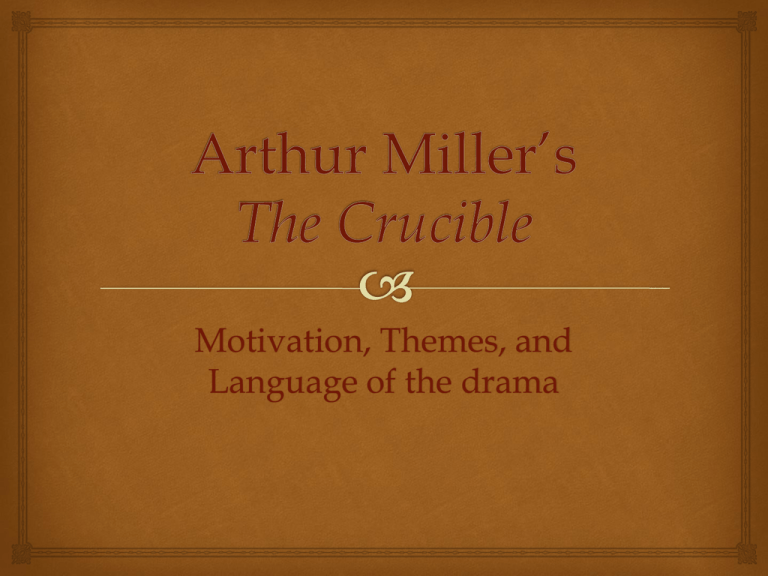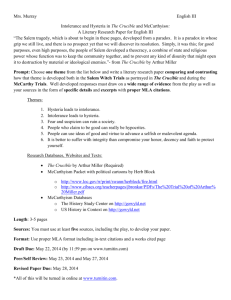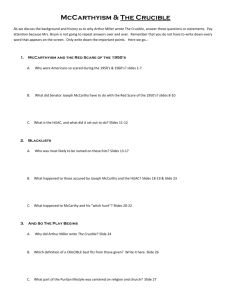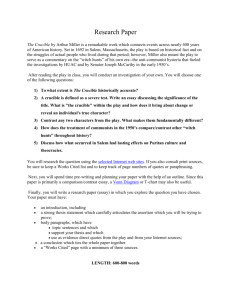File - Mrs. Nelson's English III American Literature Unit Plan
advertisement

Motivation, Themes, and Language of the drama • • • • I. II. Mrs. Nelson’s 11th grade on level American Literature English Using Socratic Seminar to discuss and analyze the motives, themes, and language of Arthur Miller’s drama The Crucible. Materials: None Summary (and Rationale): Examine the historical context of a consciously historical work of literature. Compare facts with the fictional or dramatic treatments of the facts. Ponder the differences between history and literature. Recognize the close ties between a nation's history and culture and the literature it produces Focus and Review (Establish Prior Knowledge): [time] None. This lesson will proceed directly after watching a recorded performance of the play. Objective and Assessment: 2 min. Objective: When given a work of literature with historical context, a student will be able to: •Examine the historical context of a consciously historical work of literature •Compare facts with the fictional or dramatic treatments of the facts •Ponder the differences between history and literature. •Recognize the close ties between a nation's history and culture and the literature it produces Assessments: • Students who participate in the discussion will be given a 2 point participation grade for each time they add to the discussion • Closure (Plan for maintenance): [time] 5 min. Students will continue to be involved in group discussions and analyzing historically relevant text throughout the semester. • VI. Independent Practice: [time] Throughout the semester to gain proficiency in analyzing texts, reasoning and group discussions • NC StandardsRL.11-12.1 , RL.11-12.2 , RL.11-12.7 , RL.11-12.10 , RI.11-12.3 , RI.4, RI.6, RI.10 SL. 1, SL.1a, SL.1c, SL.1d, SL.3 L.1a, L.1b, L.3, L.3a, L.4,L.4a, L4b, L.4c, L.4d, L.5 • Differentiation-Multiple level of questions. • References• • • • Coia. "Character Recipe Mr. Coia English 5-6." Web English Teacher. Mr. Coia, n.d. Web. 23 Apr. 2013. <http://www.mrcoia.com/school/pdf/11/cruc Miller, Arthur. "The Crucible: Literature Guide (Page 5) - TeacherVision.com." Teacher Lesson Plans, Printables & Worksheets by Grade or Subject - TeacherVision.com. TeacherVision, n.d. Web. 22 Apr. 2013. <http://www.teachervision.fen.com/historical-fiction/literatureguide/3498.html?page=5&detoured=1>. "Salem Witch Trials | Free Lesson Plans | Teachers | Digital textbooks and standards-aligned educational resources ." Welcome to Discovery Education | Digital textbooks and standardsaligned educational resources . Discovery Education, n.d. Web. 22 Apr. 2013. <http://www.discoveryeducation.com/teachers/free-lesson-plans/salem-witch-trials.cfm>. "SparkNotes: The Crucible: Themes, Motifs & Symbols." SparkNotes: Today's Most Popular Study Guides. Sparknotes, n.d. Web. 22 Apr. 2013. <http://www.sparknotes.com/lit/crucible/th Motivation People have motives for their actions. In this drama, different motives drive characters to act or react. Objective: You will demonstrate your understanding of a character by “creating” them in a recipe form. Preparation Tips: Prewriting & Writing Select a character from The Crucible. • List character traits and descriptions as they appear in the novel. • Determine and list events or forces that they believe helped shape the character. • Look at a few recipes from magazines to see how they are written. • Create a recipe that the author might have used to develop the character they have selected. Baste themselves in creative juices every so often. Revising & Proofreading • Stir. Add ingredients. Check to make sure preparation instructions are clear and in logical order. • Check spelling, abbreviations for measurements, and that preparation instructions are delivered using imperative sentences (if you don’t know what one is, find out!). Reverend Hale’s Puritan Turnovers Ingredients: 3 cups Religious Fervor (Puritan flavor) 1 cup Fear of Authorities 1 bunch Books Weighted with Authority 3 heaping tablespoons Pride 2 cups Faulty Logic 3 drops Yellow food coloring pinch of Truth 1 pint Compassion sprinkle Guilt 1 piece Rope Directions: Start with Religious Fervor and Books Weighted with Authorities. Knead until thoroughly mixed. Slowly fold in Faulty Logic, one chunk at a time. Sprinkle Pride over mixture and blend until thoroughly combined. Place in a hot Salem kettle. When mixture is in the heat, the backbone will be exposed. Carefully remove and discard. Add Yellow food coloring. During cooking, mixture will slowly turn colors. Carefully add Truth. The yellow color will fade, giving way to a vibrant color. The Pride in the mixture will shrink, giving way to a healthier formation. Add Compassion. The Turnovers will remove themselves from the heat. Serve on a plain dish, garnished with a portion of Rope . Preparation Time: Three months Serves: Two people: Elizabeth and John Let’s Discuss the Language of the Play Dramatic irony is the contradiction between the situation developed in a drama and the words or actions of the characters that is understood by the audience but not by the characters themselves. What examples of irony do you see in the play? A paradox is a person, situation, or action having seemingly contradictory qualities or phases. What events in Salem can be viewed as paradox? Themes The Crucible is set in a theocratic society, in which the church and the state are one, and the religion is a strict, austere form of Protestantism known as Puritanism. Because of the theocratic nature of the society, moral laws and state laws are one and the same: sin and the status of an individual’s soul are matters of public concern. There is no room for deviation from social norms, since any individual whose private life doesn’t conform to the established moral laws represents a threat not only to the public good but also to the rule of God and true religion. In Salem, everything and everyone belongs to either God or the devil; dissent is not merely unlawful, it is associated with satanic activity. Themes Reputation is tremendously important in theocratic Salem, where public and private moralities are one and the same. In an environment where reputation plays such an important role, the fear of guilt by association becomes particularly pernicious. Focused on maintaining public reputation, the townsfolk of Salem must fear that the sins of their friends and associates will taint their names. Various characters base their actions on the desire to protect their respective reputations. Which characters are concerned with their reputation in society? Themes Another critical theme in The Crucible is the role that hysteria can play in tearing apart a community. Hysteria supplants logic and enables people to believe that their neighbors, whom they have always considered upstanding people, are committing absurd and unbelievable crimes—communing with the devil, killing babies, and so on. In The Crucible, the townsfolk accept and become active in the hysterical climate not only out of genuine religious piety but also because it gives them a chance to express repressed sentiments and to act on long-held grudges. Which characters gain something by inciting and maintaining hysteria? What do they gain and why? What do you think? Which scenes/characters affected you most strongly and why? Before reading The Crucible, we researched the Salem witch trails. Let’s talk about the value of literature written in the 20th century about a period 300 years earlier-in trying to understand the historical period dramatized. There are no right and wrong answers to this question, but it’s important to think about how a literary version can help you as well as mislead you.




